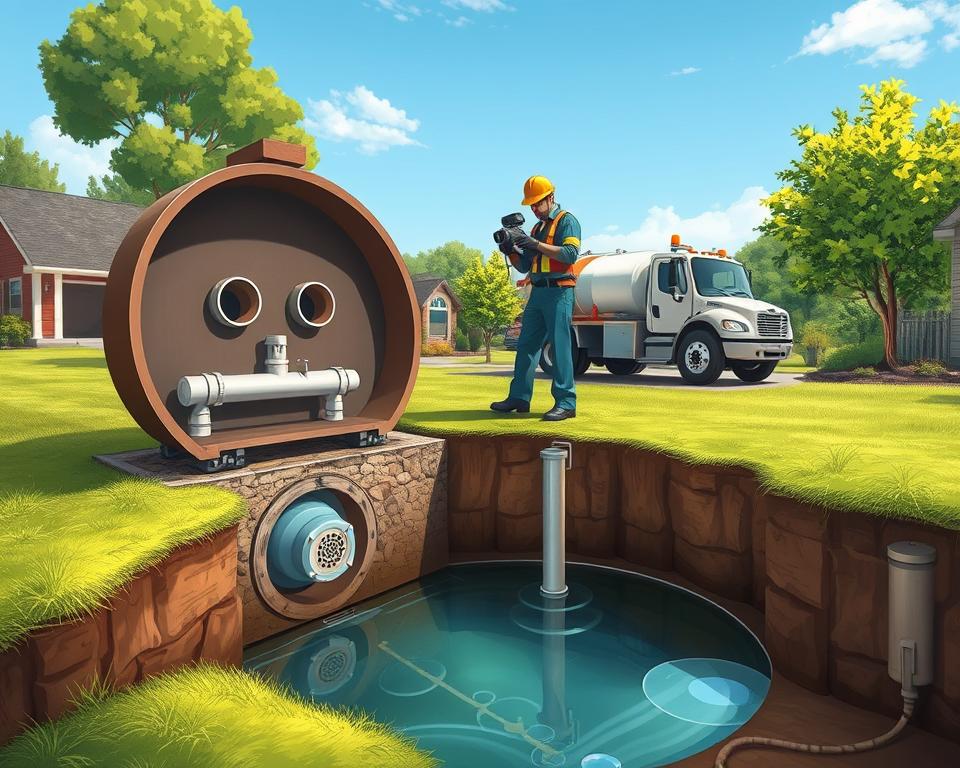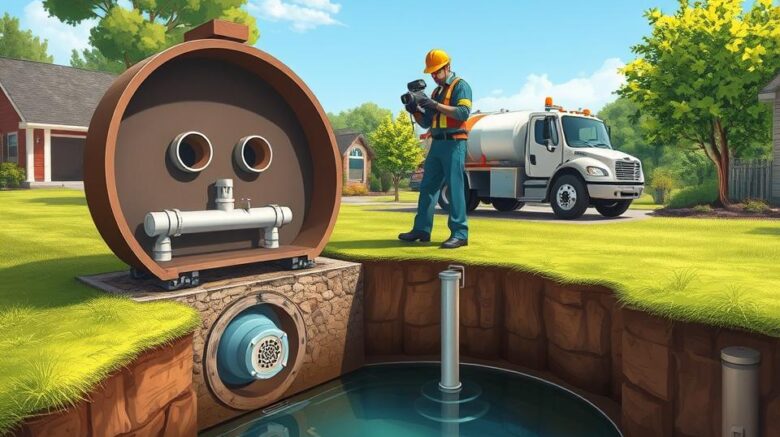Septic Aerator Pump: Must-Read Guide for Residential Users
Have you ever wondered what boosts your aerobic septic system’s performance? The aeration device is the often-overlooked hero crucial for your system. Through this guide, property owners will acquire valuable knowledge on the air Pump’s role. It’s essential for a well-functioning, effective Septic tank.
Appreciating the importance of a Septic tank air Pump can boost your Septic system’s operation using septic tank cleaning companies. It also preserves your asset value and local environment. Our handbook will introduce All in Sanitation, a leading Septic industry leader. They’re equipped to serve your Septic aerator Pump needs.
Primary Highlights
- The Septic air Pump is paramount for oxygen-based Septic setups.
- Properly caring for your Septic system air Pump can improve overall system operation.
- Periodic reviews lengthen the durability of your Septic tank air Pump.
- Picking the best-fit Septic aerator Pump is necessary for top operation.
- All in Sanitation delivers dedicated services for Septic air Pump solutions.
Breaking Down Aerobic Septic Units
Aerobic Septic systems present a enhanced waste treatment approach by utilizing oxygen. This process employs aerobic bacteria living in well-oxygenated environments. These bacteria are faster in breaking down organic matter. With the help of Septic aerator Pumps, these systems ensure a continuous oxygen supply, improving the waste decomposition process.
These systems shine in reducing sludge buildup, owing to the activity of aerobic bacteria. This drop in solid waste means reduced upkeep and periodic Pump service is necessary. Additionally, they reliably process wastewater, leading to little to no smell. This creates a better environment for homeowners and the community together.
To ensure these systems work successfully, it’s crucial to understand the key Septic system components. These include the Septic tank, aeration chamber, and effluent Pump. Each element serves a key function, especially the air Pump. It injects oxygen into the tank, vital for the aerobic bacteria’s efficiency.
Role of the Septic Air Pump
The Septic air Pump is central in the performance of aerobic Septic systems. It serves as the system’s “air provider,” delivering the critical oxygen essential. This oxygen enables aerobic bacteria to thrive and decompose waste efficiently. If the Pump breaks, the system’s performance drops, bringing about sludge collection and possible odors.
Such issues can interfere with Septic system operations and lead to environmental hazards. By recognizing how important the Septic air Pump is, homeowners can act preemptively. They can keep its best function through regular maintenance. This wards off failures, sidesteps costly repairs, and keeps the aerobic system’s well-being.
Top Advantages of Using a Septic Air Pump
Operating a Septic air Pump significantly boosts the performance of Septic systems. Septic air Pumps are key as they speed up the breakdown of waste. This is done by oxygenating the treatment process, promoting aerobic bacteria growth. These bacteria are essential for effective waste treatment.
They’re also helpful in minimizing foul smells. Thanks to more active aerobic processes, waste is processed faster, thus reducing odors. This creates a nicer atmosphere for homeowners.
Another noteworthy benefit is the cut in sludge collection. Consequently, tanks necessitate less frequent Pumping, reducing both money and time. Better processing not only reduces spending but also lengthens the lifespan of the drain field.
Servicing these Pumps correctly means reduced repair costs and meeting regulatory standards. Thus, the benefits of Septic air Pumps extend past for homeowners. They also enhance environmental health by improving waste management practices.
| Benefit | Description |
|---|---|
| Fast Waste Breakdown | Enhanced aerobic activity speeds the decomposition process. |
| Minimized Odor Emissions | Better treatment efficacy results in fewer odors. |
| Reduced Sludge Buildup | Reduced Pumping and maintenance are required. |
| Extended Drain Field Life | Better treatment means a healthier drain field. |
| Cost Savings | Lower probability of repairs and regulatory compliance cost. |

Picking an Ideal Septic Air Pump
Choosing the correct Septic air Pump is critical for an effective aerobic system. Homeowners ought to review various factors for the best fit. The capacity of the tank and the airflow demands are important the Pump’s effectiveness.
To select well, it’s essential to be aware of the air Pumps available. There are mainly two types: diaphragm Pumps and rotary vane Pumps. Each offers distinct advantages, which should be aligned with your home’s unique requirements and operational profile.
Energy efficiency also deserves attention. Selecting a Pump that reduces energy use while delivering the needed airflow can offer noticeable cost cuts. Guidance from All in Sanitation specialists can be extremely useful. They verify the Pump you choose matches your system’s requirements seamlessly.
Typical Classes of Septic Air Pumps
Homeowners can choose intelligently by being aware of the different Septic air Pumps available. There are mainly two types: diaphragm Pumps and rotary vane Pumps. Each has its individual functions and benefits.
Diaphragm Pumps, known for their quiet operation, are favored for residential Septic systems. They maintain energy efficiency while providing steady air flow. Their reliable performance fits smaller systems, appealing to many homeowners.
Rotary vane Pumps, however, are well-suited for bigger or commercial systems. These Pumps deliver more power, required when handling bigger loads. Their strong build guarantees efficient operation in heavy-duty Septic systems.
| Type of Pump | Best Use | Advantages |
|---|---|---|
| Diaphragm Pumps | Residential Systems | Quiet operation, energy-efficient, reliable air flow |
| Rotary Vane Pumps | Larger or Commercial Systems | Powerful performance, high capacity, durable construction |
Understanding the distinctions in Septic air Pumps is important for upgrades or replacements. Each Pump type offers specific features to meet various needs. This ensures best performance for any system.
Signs You Might Need a Septic Air Pump Replacement
Homeowners must monitor Pump failure signs in their Septic systems. Some clues show the need for a Septic air Pump replacement. These support reliable function. Spotting these promptly sidesteps bigger issues.
Signs of potential problems include:
- Unusual noises from the Pump, like rattling or buzzing, might mean internal damage.
- A clear lack of air output suggests the Pump isn’t performing as intended, harming efficiency.
- Regular electrical problems, such as power trips or lights dimming, could show overloading.
- Visible damage on the Pump unit, with cracks or leaks, requires quick action.
- Unpleasant odors in the yard often signal a compromised Pump, highlighting ineffective effluent aeration.
Finding these signs early avoids costly fixes or total system failure. Conducting routine inspections helps spot these issues. It also demonstrates if you should get a new Septic air Pump.
Care Guidelines for Your Septic Air Pump
For an well-running Septic air Pump, routine upkeep is crucial. This guarantees that your system works smoothly. Homeowners can follow several simple care strategies for peak results.
Every six months, run a careful inspection for wear or damage. It is also essential to replace the filters as indicated. This reduces clogs that could reduce efficiency.
The Pump should sit on a firm base to lessen vibrations, which could damage it over time. A protective cover is critical too. It defends against debris and water, sustaining the Pump’s functionality.
Good upkeep can greatly increase the life of your Pump. In turn, this helps the Septic system’s performance overall.
| Maintenance Task | Frequency | Benefits |
|---|---|---|
| Inspect Pump for damage | Every 6 months | Catches problems quickly |
| Replace filters | As needed | Keeps performance up |
| Check surface stability | Annually | Minimizes shake |
| Clear debris around Pump | Monthly | Avoids obstruction |
Setting Up Your Septic Air Pump
Accurate installation of your Septic air Pump is critical for its optimal operation. At the outset, pick a reliable, moisture-free area for placement. The chosen spot should securely support the Pump’s weight with ease.
To effectively fit your Pump on your own, use the following guidelines:
- Collect all necessary items, including the Pump, a power source, and hose fittings.
- Thoroughly review the manufacturer’s guidelines before beginning your installation.
- Verify every connection is sealed to stop air leaks that impact performance.
- After assembly, conduct a test to ensure the system works as intended.
If the installation process looks challenging, contact All in Sanitation. Their professionals can sidestep common errors, confirming your setup follows necessary safety requirements.
Advantages of Using All in Sanitation for Your Septic Air Pump Services
When deciding on a Septic service provider, the choice is significant. All in Sanitation distinguishes itself by providing dependable Septic air Pumps. They serve diverse homeowner requirements with a wide selection of top-tier products. This makes sure customers find an appropriate match for their Septic systems.
What really sets apart All in Sanitation is beyond their extensive product lineup. Their dedication to superior customer service is just as important. Homeowners get expert advice, helping them choose trusted Septic solutions. This partnership is essential to customize each solution to meet specific needs.
All in Sanitation also emphasizes aftercare to deliver lasting satisfaction. Their devotion continues beyond the initial sale. They provide ongoing support to ensure Septic systems operating efficiently for the long term.
Expense Overview for Septic Air Pumps
Knowing the price factors tied to Septic air Pumps is important for homeowners using aerobic Septic systems. Initially, one faces the initial cost, which includes the Pump and associated accessories. Installation expenses fluctuate, depending on the system’s complexity and any adjustments required.
Ongoing upkeep forms an additional cost layer. Periodic reviews can head off bigger issues, which can mean savings. Homeowners should set aside funds for Septic maintenance to keep the Pump’s effectiveness and service life. Such planning helps dodge expensive repairs later on, showing the advantage of proactive maintenance.
| Cost Component | Average Cost Range |
|---|---|
| Septic Air Pump | $500 – $1,200 |
| Installation | $300 – $800 |
| Annual Maintenance | $150 – $400 |
| Potential Repair Costs | $1,000 – $5,000 |
Dividing Septic air Pump expenses into individual parts supports homeowners in budget planning. This thorough approach secures the system’s consistent operation and their confidence.
To Conclude
For homeowners with aerobic Septic systems, maintaining Septic setups is essential. The right Septic air Pump improves waste processing and extends your system’s life. Sticking with regular upkeep and promptly addressing issues prevents costly fixes and disruptions.
Opting for a Septic air Pump requires deliberation. This guide covered how to make smart choices about installation and replacement. With All in Sanitation’s expertise, you can tackle your Septic systems’ complexities confidently.
Attending to your Septic air Pump improves your system’s performance and life span. It guarantees a smooth and optimal operation over time. Don’t forget, your home’s wastewater management is strongly influenced by consistent upkeep.
